Periodontal (Gum) Disease Therapy in Lisle
 If someone asked you, “What is the most prevalent disease in the US?” What would you say? Many people think it’s heart disease, cancer, or some other systemic illness. It’s actually something most people don’t know much about – periodontal disease.
If someone asked you, “What is the most prevalent disease in the US?” What would you say? Many people think it’s heart disease, cancer, or some other systemic illness. It’s actually something most people don’t know much about – periodontal disease.
The word periodontal is a combination of two Greek words. Perio means around and odont means tooth. It’s better known simply as gum disease. By any name, the disease is extremely prevalent among adults in the United States. Some research indicates that about half of adults over the age of 30 have some form of the disease, and that number increase significantly to about 80% after the age of 35. A disease affecting this many people deserves our attention, and we screen for periodontal disease at every dental checkup. For those patients who already suffer from gum disease, we also provide a number of periodontal therapies to renew oral health. If you’re looking for help with periodontal disease in the Lisle area, we invite you to contact Arbor Dental Care to schedule a treatment consultation today.
What is Gum Disease?
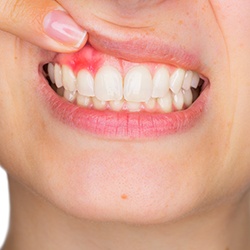
This common oral health condition occurs when bacteria, plaque, and tartar at the gum line irritates and even destroys the supportive gum and bone tissues around teeth. When this occurs, the resultant effects are minimal at first, but without treatment, the disease can lead to shifting teeth, chronic bad breath, or tooth loss. There are two forms of gum disease. The mild type is often referred to as gingivitis, and its symptoms can be easily overlooked by the untrained eye. They include things like mild bleeding during teeth cleaning, receding gum tissue, and bad breath. As the disease progresses into the more advanced form, periodontitis, the side effects are significantly more pronounced, and they include the following:
- Severe gum and supportive bone tissue recession
- Teeth that move or feel loose
- A bite that doesn’t fit together naturally
- Chronic, severe bad breath
- Inflamed, swollen, infected, or bleeding gums
- Unexplained tooth loss
How to Treat Gum Disease
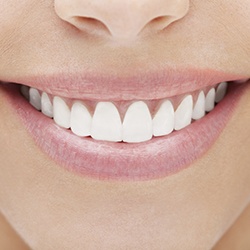
This condition can lead to numerous, severe oral and overall health concerns, so it’s essential that any patient with gum disease seek out periodontal therapy right away. Without treatment, gum disease profoundly impacts oral health, and recent research has indicated a close connection between gum disease and chronic, systemic illnesses like diabetes, heart disease, and Alzheimer’s. The sooner we begin treatment, the more likely we’ll be able to restore complete oral health with minimally invasive solutions. In the earliest stages, improved at-home hygiene and more frequent professional cleanings may be effective in treating gum disease. In the advanced stages, treatments may include the following:
- Scaling – careful removal of bacteria, plaque, and tartar
- Root planing – the smoothing of roots to prevent future plaque and tartar buildup
- Antibiotic therapy – we may use antibiotics to reduce or limit the amount of oral bacteria
- Laser treatment – is the preferred method of performing most periodontal therapies as it is more comfortable and reduces healing time following treatment
Scaling & Root Planing
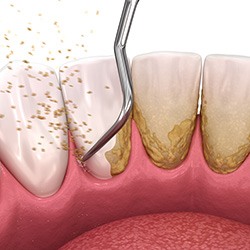
If your body is exhibiting any early signs of gum disease, we might suggest scaling and root planing. Sometimes called a “deep cleaning,” this procedure allows us to thoroughly remove all lingering oral bacteria and ease your symptoms. We’ll remove all plaque and tartar from the surface of the teeth before smoothing down your roots to allow for optimal healing. Read on to learn more about scaling and root planing and how it works.
Do I Need Scaling & Root Planing?
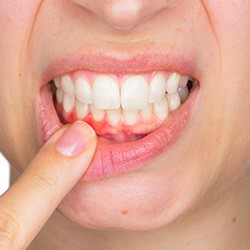
If we notice any signs of gum disease during your routine checkups, like bleeding, swelling, and inflammation, we will address it as soon as we can to prevent it from progressing and resulting in permanent damage to the gums and surrounding structures. The point of this procedure is to remove bacterial buildup around and beneath the gumline before smoothing down the roots to allow the area to heal.
The Process of Scaling & Root Planing
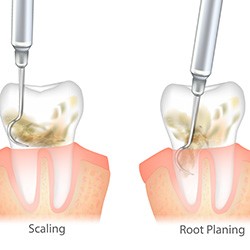
Scaling and root planing take place over two separate appointments. The first one consists of the “scaling.” This is when we use dental tools to remove plaque and tartar that have accumulated along and beneath the gumline using dental instruments.
After we’ve completed the scaling, we will move on to the root planing portion. At this point, we will smooth down the parts of the teeth that are normally hidden by the gums/ This will help the gums to better adhere to the teeth, making it more challenging to for bacteria to build up and again. This also reduces your future risk of gum disease.
Aftercare Tips for Scaling & Root Planing
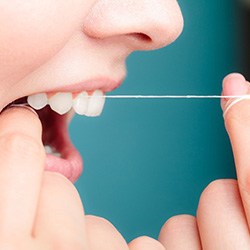
It is common for patients to experience some sensitivity after they receive scaling and root placing. You could also experience some swelling in the area. This is normal and temporary, so it should resolve itself. Here are a handful of tips to help you recover quickly:
- Brush twice daily using a soft-bristled toothbrush
- Use a saltwater rinse after eating
- Floss thoroughly every day
- Stick to a soft-food diet for 48 hours after your treatment
- Avoid spicy, acidic, and hot foods
- Refrain from strenuous activities after your treatment
Laser Periodontal Treatment
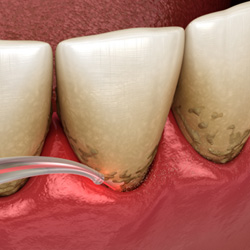
Bacteria in the gumline can increase your risk of multiple health issues, such as bone and tissue loss, diabetes, and heart disease. Fortunately, our team at Arbor Dental Care can keep your gums healthy with laser periodontal treatment. Utilizing a Diode laser, we can effectively target problem areas while ensuring your comfort. To learn more about how this technology works, continue reading.
How Laser Periodontal Treatment Works
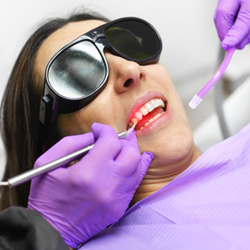
Laser periodontal treatment is a minimally invasive procedure used alongside deep cleaning (scaling and root planing) to combat gum disease. Instead of using a scalpel, we’ll target inflamed and infected tissue with a Diode dental laser, reducing bacteria and preserving healthy gums. This approach minimizes discomfort and promotes faster healing.
By removing damaged tissue and sterilizing the area, the laser helps healthy gums reattach to teeth and protects the roots from further infection. Afterward, scaling and root planing is performed to eliminate plaque, tartar, and hardened bacteria.
The Benefits of Laser Periodontal Treatment
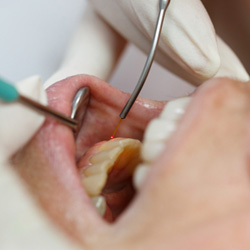
By using a precise laser instead of a scalpel, this treatment is far less invasive and more comfortable than traditional methods. The Diode laser kills bacteria on contact, reducing infection risk and promoting faster healing. There’s no need for sutures, and post-operative effects (e.g., discomfort, bleeding, inflammation) are minimized thanks to the laser’s cauterizing effect. Plus, it lowers the chance of post-treatment infections. Because the laser targets only diseased areas, more healthy tissue is preserved. Studies even show it can reduce the risk of future gum disease!
Aftercare Tips for Laser Periodontal Treatment

Recovery after laser periodontal treatment is typically quick, with most patients fully healed within a week. That’s much faster than the two to four typically weeks needed for traditional gum surgery!
Some mild swelling or sensitivity is normal and can usually be managed with over-the-counter pain relievers like ibuprofen. To support healing, maintain good oral hygiene by brushing twice daily and flossing regularly. Avoid foods that are hot, cold, or spicy to minimize discomfort. A follow-up visit with our team is important so we can monitor your progress. If the pain worsens or unusual symptoms appear, don’t hesitate to contact our dental office for assistance.


